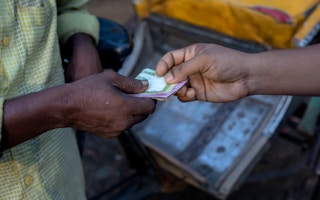Nearly 300 million people around the world will need humanitarian aid in 2024, according to the United Nations, but after a record shortfall in donations last year, aid workers are bracing for the funding crisis to continue.
Only a little more than one-third of the US$57 billion required to provide aid was funded last year, the UN Office for the Coordination of Humanitarian Affairs (UNOCHA) said in its annual assessment of global humanitarian needs.
The gap prompted the UNOCHA to reduce the size of its annual aid appeal in December, urging donors to provide US$46.4 billion to carry out the global aid response in 2024.
So why is the aid gap growing and what sectors are most in need?
How much is the global aid bill?
This year, the UN is targeting the lowest ever percentage of people in need based on its capacity to deliver - some 180 million of the 299 million people estimated to require assistance, UNOCHA has said.
The biggest share - some US$19 billion - is earmarked for sub-Saharan Africa, followed by US$13.9 billion for the Middle East and North Africa, including assistance to Palestinians affected by the war in Gaza and more than 32 million Syrians.
Other major aid hotspots include Afghanistan and Venezuela, according to the UNOCHA assessment.
Separately, the UN children’s agency UNICEF has appealed for US$9.3 billion to help vaccinate, educate, feed and protect 94 million children, while the UN refugee agency, UNHCR, is aiming to raise over US$10 billion to manage record levels of displacement worldwide.
“
Needs are exploding, while international solidarity is shrinking.
Jan Egeland, secretary general, Norwegian Refugee Council
The World Health Organization has called on donors to raise US$1.5 billion for the year ahead, after a significant drop in funding last year.
Why is the aid gap growing?
UNOCHA’s assessment of global aid needs reached a high of almost US$57 billion in 2023 as new conflicts, more frequent climate emergencies and rising food insecurity forced more people to face multiple, protracted crises.
Growing debt is forcing some countries to spend more on interest payments than on measures to abate emergencies – dragging out crises and increasing their reliance on external aid.
At the same time, some wealthy donor countries have been cutting their aid spending.
In 2023, the United States cut its contributions to the International Committee of the Red Cross and Britain confirmed it would keep its official development assistance at 0.5 per cent of gross national income - after reducing it from 0.7 per cent during the Covid-19 pandemic - until its fiscal situation improved.
Germany also plans to cut development assistance for 2024 by almost a billion euros.
Where are the biggest shortfalls?
Several UN programmes were cut in 2023 due to shortfalls in funding, with major setbacks felt by the World Food Programme (WFP) as it faces rising food insecurity driven by climate change, conflict and disruptions to global supply chains.
Some 571 million people were living in food poverty in 2023, 42 million more than in 2019, data research organisation Development Initiatives found. Acute food insecurity is expected to worsen in 18 hotspots across Africa and the Middle East in 2024, according to the WFP.
The WFP experienced a 60 per cent funding shortfall in 2023. Cuts will affect nearly half of its 86 country operations, including programmes in Afghanistan, Bangladesh, Yemen, Northern Syria and West Africa, which could push a further 24 million people into food insecurity.
The funding gap for hunger appeals grew by 23 per cent in 2023, with 65 per cent of needs unmet at the beginning of 2024.
Shelter, and water, sanitation and hygiene programs also face funding shortfalls, increasing people’s exposure to disease, while Venezuela has received just over 30 per cent of a US$720 million UN appeal amid a long political and economic crisis.
Programmes related to gender equality have also been hit.
What’s in store for the future?
In December, initial donations to the UN’s emergency fund CERF, the Central Emergency Response Fund, for 2024 totalled US$419 million, exceeding 2023’s contributions, with several donors announcing forthcoming pledges.
But despite some glimmers of hope, aid workers say they fear for the years ahead.
“Needs are exploding, while international solidarity is shrinking,” Jan Egeland, secretary general of the Norwegian Refugee Council, told Context.
He said the “loss and damage” fund launched at the COP28 climate conference in Dubai could help to reduce needs from climate emergencies in the future but will not help raise funds for those already facing destitution.
So far, about US$656 million has been pledged towards the fund.
Egeland said Gulf countries should start contributing to coordinated humanitarian responses and that he hoped to see hundreds of millions of dollars stuck in frozen funds unlocked for aid packages.
In October, the UN gave the green light for a package of financial aid from frozen Venezuelan assets.
This story was published with permission from Thomson Reuters Foundation, the charitable arm of Thomson Reuters, that covers humanitarian news, climate change, resilience, women’s rights, trafficking and property rights. Visit https://www.context.news/.

















